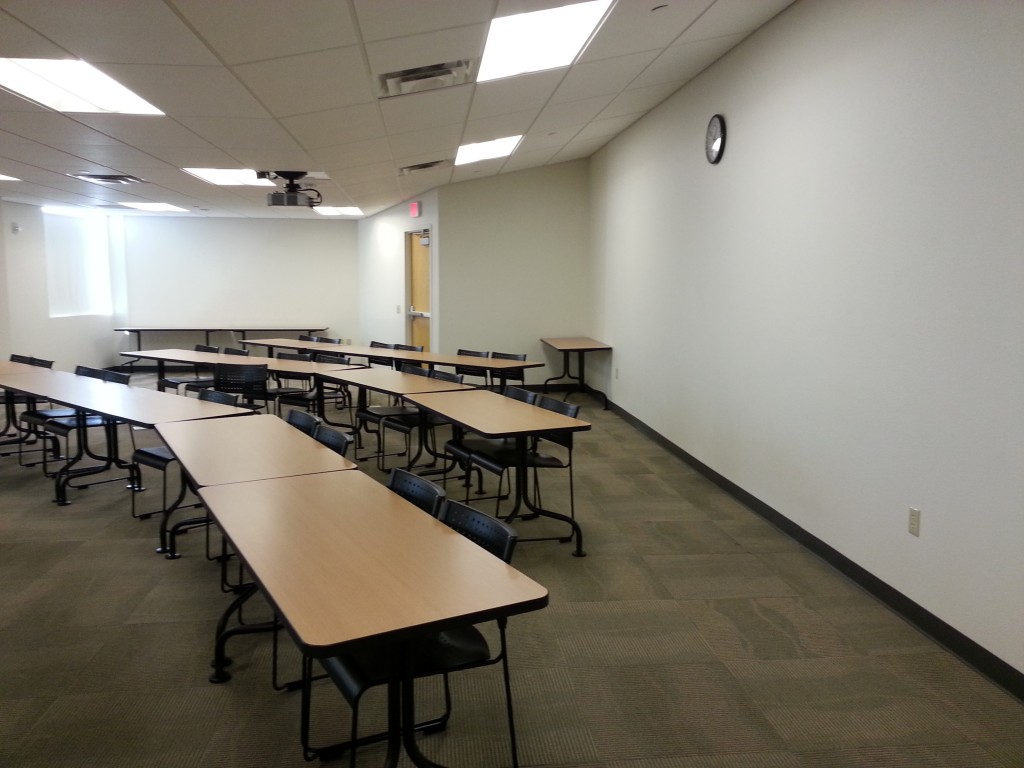I am off to a leadership retreat for the weekend so here is review of the week for me. As the class “Moderator” this week I added what I figured was a relevant questions on Facebook about design is academic spaces and I commented on some posts.
Personal stories often work as a way to make stuff accessible and relevant to others so I will try to share like that. This week, strangely, I had several conversations about the ol’ “learning spaces” with faculty here at the college as the classrooms here were recently refurbished, reshaped, and redesigned and include no art (or even motivational posters) on the walls, no plants, no easily movable student desks, projector screens that hang in front of windows (that is called being “backlit” which makes viewing challenging) and instructor lecterns in far corners of the room furthering the distance between teacher and student. Dang, was that one run on sentence or what? And I will liken the design of a room with the design of a “online” room/class.
Below is one of the rooms. The ONE thing on the walls is a clock. And it is at the back where the only person who can see it easily is the teacher. How is that for student centered learning?
Anyway, it is a hot topic here now and while it may not relate directly to online spaces, I cannot dismiss the element of aesthetic in learning environments so I figure I’ll stay with it for now.
At the point teachers get to me to work on a class or some specific content in a class they often have already figured out what the assessments are and what objectives need to be met. I enjoy working with teachers who are willing to wonder about the types of assessments they have used and the kind they might like to use. Often, we are still in the land of true false or multiple choice questions that the publisher has provided and can be easily slipped into a test and automatically graded. I always say easy in hardly ever better and better almost always makes you sweat. Or I guess that is what I say to myself while I am running on the damn treadmill.
And on the treadmill , like in life, I try to clear my mind of the clutter and imagine the perfect spaces. They look like this when I am good and focused.
And even, in the spirit of basic artistic principles and stopping to smell and focus on a rose every once in a while, they look like this.
But often, online classes and textbooks look like this and I get nervous because they have 437 pagesI can’t get that much in at one time. Or there are five folders in week one and each folder has six or more items and each item tells me to go somewhere else. I am lost and out of energy and the treadmill is starting to hurt me.
And even in my worst nightmares, which thankfully I do not have (because all my dreams have come true) I might see classes that look like this inside and out and I shiver.
When I work with teachers who are new to teaching online I try to get them to fist DRAW the class using a pencil and large piece of paper. It is funny how resistant they are to actually doing that. We even have that as an assignment in our new faculty Face-to-Face class about online learning and some of the teachers just refuse and the do it in Word as an outline or bulleted list. Pretty funny. It is like drawing the class is not serious enough? Nothing intelligent can be drawn, right? Anyway, I think that being able to storyboard the class on a large piece of poster board allows connections to be made and makes the “flexibility” of the class visible. It encourages revision that is somehow different than what a digital Word document does. Maybe learning styles play into this and that is where some of the resistance comes from. That is probable true.
After the big storyboard we start in earnest to organize, rethink, redraw, create content, talk about our families and, in my case, the treadmill, and play and experiment. And it is within all that stuff that the design is born. I think.
It is important to me to remember as I run on that damn treadmill that I can’t just stop tomorrow and reach my goal. The goal is distant and will take much hard work to get there and I probably would be unhappy when I get “there” anyway so I have to remember that there may be no “destination” but rather it is THIS panting and running and running that IS the place I want to BE.
No matter how much it hurts.
Deep sigh.





Reminds me of another story. A friend of mine who used to teach chemistry & astronomy here hung astronomy posters around his classroom (which was also used for other classes). Another instructor complained and asked him to take the posters down because they were too distracting to the students in other classes.
That was one of the nice things about teaching high school. No sharing. It was all mine…..
Here at the college we have similar challenges. Certainly we would never want History teachers to put nice pictures of Europe, or maps of Europe, in a class that was also used for say, literature courses. Or maybe some rouge Sociology teacher putting up posters about diversity in a classroom also used by a Biology instructor. The shame. The distractions. The possibilities…. Yikes.
Luckily the earthquake emergency procedures and evacuation posters aren’t in the least distracting.
Our classrooms all have flags and framed constitutions placed in rooms post 9/11.
They were hung and placed in strategic locations by maintenance workers. Those and an occasional fire extinguisher.
Maybe the people resistant to drawing should see an RSA thing?
I just looked over the post and found numerous spelling errors and lapses in judgement. Sorry all.
While reading the poster board drawing assignment, I first felt, “yuck, I would not like to do that”. However, what a way to begin to organize through the use of kinesthetic, visual and spatial aspects. And I believe “element of aesthetic” has everything to do with online learning environments. My Bb is not aesthetically pleasing. If I expect my students to visit and stay more often I need to ramp it up!
Hi Todd – I would like to respond to this part of your post
>Certainly we would never want History teachers to put nice pictures of Europe, or maps of Europe, in a class that was also used for say, literature courses.
If you teach in primary schools (in the UK this is 5-11 year olds), then in the UK one teacher has a class of up to 30 or more children and teaches them all subjects. Wall displays are considered a very important aspect of classroom teaching – so a mathematics problem solving display can go up right beside a display of Egyptian Hieroglyphics.
If young children can work in these environments without being over distracted by the displays – then surely adults can.
But other points of displays that they are not simply displays. They are teaching tools with which children can interact and which teachers can use for a variety of teaching purposes – so a display of Egyptian hieroglyphics could be used as a catalyst for creative writing, or art.
But for autistic children, for example, too much visual stimulation on the walls might literally be ‘painful’ – or for other children too much ‘red’ might over excite them, whereas too much ‘blue’ might make them too passive.
So – I agree Todd – how we design our learning spaces – what we ‘put on the walls’ is so important to consider -whether on or offline.
I know this doesn’t respond to the main points in your post – but for me, I would find the first classroom image you posted, too sterile and clinical. Although I could cope with it as an adult, I think it is too lacking in stimulation, maybe even for an autistic child.
So how does this equate to online spaces?